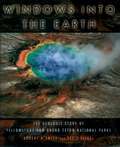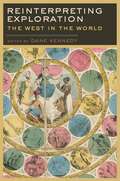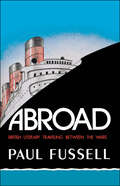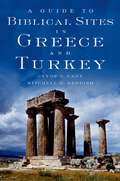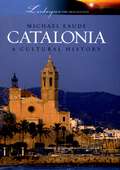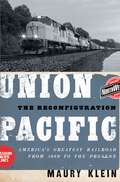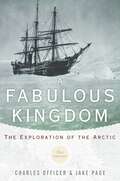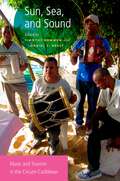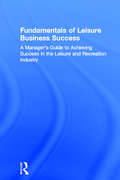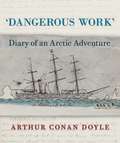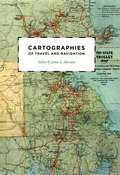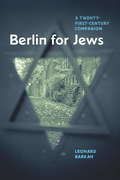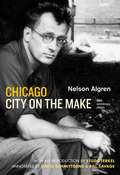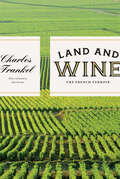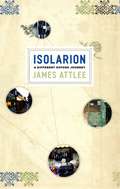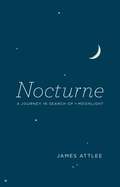- Table View
- List View
Windows into the Earth: The Geologic Story of Yellowstone and Grand Teton National Parks
by Robert B. Smith Lee J. SiegelMillions of years ago, the North American continent was dragged over the world's largest continental hotspot, a huge column of hot and molten rock rising from the Earth's interior that traced a 50-mile wide, 500-mile-long path northeastward across Idaho. Generating cataclysmic volcanic eruptions and large earthquakes, the hotspot helped lift the Yellowstone Plateau to more than 7,000 feet and pushed the northern Rockies to new heights, forming unusually large glaciers to carve the landscape. It also created the jewel of the U.S. national park system: Yellowstone. Meanwhile, forces stretching apart the western U.S. created the mountainous glory of Grand Teton National Park. These two parks, with their majestic mountains, dazzling geysers, and picturesque hot springs, are windows into the Earth's interior, revealing the violent power of the dynamic processes within. Smith and Siegel offer expert guidance through this awe-inspiring terrain, bringing to life the grandeur of these geologic phenomena as they reveal the forces that have shaped--and continue to shape--the greater Yellowstone-Teton region. Over seventy illustrations--including fifty-two in full color--illuminate the breathtaking beauty of the landscape, while two final chapters provide driving tours of the parks to help visitors enjoy and understand the regions wonders. Fascinating and informative, this book affords us a striking new perspective on Earth's creative forces.
Reinterpreting Exploration: The West in the World (Reinterpreting History: How Historical Assessments Change over Time)
by Dane KennedyExploration was a central and perhaps defining aspect of the West's encounters with other peoples and lands. Rather than reproduce celebratory narratives of individual heroism and national glory, this volume focuses on exploration's instrumental role in shaping a European sense of exceptionalism and its iconic importance in defining the terms of cultural engagement with other peoples. In chapters offering broad geographic range, the contributors address many of the key themes of recent research on exploration, including exploration's contribution to European imperial expansion, Western scientific knowledge, Enlightenment ideas and practices, and metropolitan print culture. They reassess indigenous peoples' responses upon first contacts with European explorers, their involvement as intermediaries in the operations of expeditions, and the complications that their prior knowledge posed for European claims of discovery. Underscoring that exploration must be seen as a process of mediation between representation and reality, this book provides a fresh and accessible introduction to the ongoing reinterpretation of exploration's role in the making of the modern world.
Abroad: British Literary Traveling between the Wars
by Paul FussellA book about the meaning of travel, about how important the topic has been for writers for two and a half centuries, and about how excellent the literature of travel happened to be in England and America in the 1920s and 30s.
A Guide to Biblical Sites in Greece and Turkey
by Clyde E. Fant Mitchell G. ReddishNearly two-thirds of the New Testament--including all of the letters of Paul, most of the book of Acts, and the book of Revelation--is set outside of Israel, in either Turkey or Greece. Although biblically-oriented tours of the areas that were once ancient Greece and Asia Minor have become increasingly popular, up until now there has been no definitive guidebook through these important sites. In A Guide to Biblical Sites in Greece and Turkey, two well-known, well-traveled biblical scholars offer a fascinating historical and archaeological guide to these sites. The authors reveal countless new insights into the biblical text while reliably guiding the traveler through every significant location mentioned in the Bible. The book completely traces the journeys of the Apostle Paul across Turkey (ancient Asia Minor), Greece, Cyprus, and the islands of the Mediterranean. A description of the location and history of each site is given, followed by an intriguing discussion of its biblical significance. Clearly written and in non-technical language, the work links the latest in biblical research with recent archaeological findings. A visit to the site is described, complete with easy-to-follow walking directions, indicating the major items of archaeological interest. Detailed site maps, historical charts, and maps of the regions are integrated into the text, and a glossary of terms is provided. Easy to use and abundantly illustrated, this unique guide will help visitors to Greece, Turkey, and Cyprus appreciate the rich history, significance, and great wonder of the ancient world of the Bible.
Catalonia: A Cultural History (Landscapes of the Imagination)
by Michael EaudeSqueezed between more powerful France and Spain, Catalonia has endured a violent history. Its medieval empire that conquered Naples, Sicily and Athens was crushed by Spain. Its geography, with the Pyrenees falling sharply to the rugged Costa Brava, is tormented, too. Michael Eaude traces this history and it monuments: roman Tarragona, celebrated by the poet Martial; Greek Empúries, lost for centuries beneath the sands; medieval Romanesque architecture in the Vall de Bo:i churches (a World Heritage Series) and Poblet and Santes Creus monasteries. He tells the stories of several of Catalonia's great figures: Abbot Olivia, who brought Moorish learning to Europe, the ruthless mercenary, Roger de Flor, and Verdaguer, handsome poet-priest. Catalonia is famous today for its twentieth-century art. This book focuses on the revolutionary Art Nouveau buildings (including the Sagrada Família) of Antoni Gaudí. It also explores the region's artistic legacy: the young Picasso painting Barcelona's vibrant slums; Salvador Dalí, inspired by the twisted rocks of Cap de Creus to paint his landscapes of the human mind; and Joan Miró, discovering the colors of the red earth at Montroig.
Union Pacific: The Reconfiguration: America's Greatest Railroad from 1969 to the Present
by Maury KleinPraised by the Chicago Tribune as "thoroughly and compellingly detailed history," Volumes I and II of Maury Klein's monumental history of the Union Pacific Railroad covered the years from 1863-1969. Now the third and final volume brings the story of the Union Pacific--the oldest, largest, and most successful railroad of modern times--fully up to date. The book follows the trajectory of an icon of the industrial age trying to negotiate its way in a post-railway world, plagued by setbacks such as labor disputes, aging infrastructure, government de-regulation, ill-fated mergers, and more. By 1969 the same company that a century earlier had triumphantly driven the golden spike into Promontory Summit--to immortalize the nation's first transcontinental railway--seemed a dinosaur destined for financial ruin. But as Klein shows, the Union Pacific not only survived but is once more thriving, which proves that railways remain critical to commerce and industry in America, even as passenger train travel has all but disappeared. Drawing on interviews with Union Pacific personnel past and present, Klein takes readers inside the great railroad--into its boardrooms and along its tracks--to show how the company adapted to the rapidly changing world of modern transportation. The book also offers fascinating portraits of the men who have run the railroad. The challenges they faced, and the strategies they developed to meet them, give readers a rare glimpse into the inner workings of one of America's great companies. A capstone on a remarkable achievement, Union Pacific: The Reconfiguration will appeal to historians, business scholars, and transportation buffs alike.
Reinterpreting Exploration: The West in the World (Reinterpreting History: How Historical Assessments Change over Time)
by Dane KennedyExploration was a central and perhaps defining aspect of the West's encounters with other peoples and lands. Rather than reproduce celebratory narratives of individual heroism and national glory, this volume focuses on exploration's instrumental role in shaping a European sense of exceptionalism and its iconic importance in defining the terms of cultural engagement with other peoples. In chapters offering broad geographic range, the contributors address many of the key themes of recent research on exploration, including exploration's contribution to European imperial expansion, Western scientific knowledge, Enlightenment ideas and practices, and metropolitan print culture. They reassess indigenous peoples' responses upon first contacts with European explorers, their involvement as intermediaries in the operations of expeditions, and the complications that their prior knowledge posed for European claims of discovery. Underscoring that exploration must be seen as a process of mediation between representation and reality, this book provides a fresh and accessible introduction to the ongoing reinterpretation of exploration's role in the making of the modern world.
A Fabulous Kingdom: The Exploration of the Arctic
by Charles Officer Jake PageInconstant and forbidding, the arctic has lured misguided voyagers into the cold for centuries--pushing them beyond the limits of their knowledge, technology, and endurance. A Fabulous Kingdom charts these quests and the eventual race for the North Pole, chronicling the lives and adventures that would eventually throw light on this "magical realm" of sunless winters. They follow the explorers from the early journeys of Viking Ottar to the daring exploits of Martin Frobisher, Henry Hudson, Frederick Cook, Robert Peary, and Richard Bird. The second edition features a section entitled "The New Arctic" that illuminates current scientific and environmental issues that threaten the region. Officer and Page discuss such topics as the science behind the melting of the polar ice; the endangered species that now depend on the ice, including polar bears, narwhals, walruses, and ringed seals; commerce in mining and natural resources, especially petroleum and natural gas; and predictions for the economic and environmental future of the region. Library Journal called the first edition a "winning fusion of adventure, suspense, and history."
A Fabulous Kingdom: The Exploration of the Arctic
by Jake Page Charles OfficerInconstant and forbidding, the arctic has lured misguided voyagers into the cold for centuries--pushing them beyond the limits of their knowledge, technology, and endurance. A Fabulous Kingdom charts these quests and the eventual race for the North Pole, chronicling the lives and adventures that would eventually throw light on this "magical realm" of sunless winters. They follow the explorers from the early journeys of Viking Ottar to the daring exploits of Martin Frobisher, Henry Hudson, Frederick Cook, Robert Peary, and Richard Bird. The second edition features a section entitled "The New Arctic" that illuminates current scientific and environmental issues that threaten the region. Officer and Page discuss such topics as the science behind the melting of the polar ice; the endangered species that now depend on the ice, including polar bears, narwhals, walruses, and ringed seals; commerce in mining and natural resources, especially petroleum and natural gas; and predictions for the economic and environmental future of the region. Library Journal called the first edition a "winning fusion of adventure, suspense, and history."
Sun, Sea, and Sound: Music and Tourism in the Circum-Caribbean
by Timothy Rommen Daniel T. NeelyMusic and tourism, both integral to the culture and livelihood of the circum-Caribbean region, have until recently been approached from disparate disciplinary perspectives. Scholars who specialize in tourism studies typically focus on issues such as economic policy, sustainability, and political implications; music scholars are more likely to concentrate on questions of identity, authenticity, neo-colonialism, and appropriation. Although the insights generated by these paths of scholarship have long been essential to study of the region, Sun, Sea, and Sound turns its attention to the dynamics and interrelationships between tourism and music throughout the region. Editors Timothy Rommen and Daniel T. Neely bring together a group of leading scholars from the fields of ethnomusicology, anthropology, mobility studies, and history to develop and explore a framework - termed music touristics - that considers music in relation to the wide range of tourist experiences that have developed in the region. Over the course of eleven chapters, the authors delve into an array of issues including the ways in which countries such as Jamaica and Cuba have used music to distinguish themselves within the international tourism industry, the tourism surrounding music festivals in Guadeloupe and New Orleans, the intersections between music and sex tourism in Brazil, and spirituality tourism in Cuba. An indispensable resource for the study of music and tourism in global perspective, Sun, Sea, and Sound is essential reading for scholars and students across disciplines interested in the Caribbean region.
Fundamentals of Leisure Business Success: A Manager's Guide to Achieving Success in the Leisure and Recreation Industry
by William WinstonEasy to read and conducive to discussion, Fundamentals of Leisure Business Success: A Manager‘s Guide to Achieving Success in the Leisure and Recreation Industry takes a practical, upbeat look at the worlds largest industry--leisure and recreation--and gives you practical tips and surefire strategies for making your own profit or nonprofit leisure
Dangerous Work: Diary of an Arctic Adventure
by Arthur Conan DoyleIn 1880 a young medical student named Arthur Conan Doyle embarked upon the “first real outstanding adventure” of his life, taking a berth as ship’s surgeon on an Arctic whaler, the Hope. The voyage took him to unknown regions, showered him with dramatic and unexpected experiences, and plunged him into dangerous work on the ice floes of the Arctic seas. He tested himself, overcame the hardships, and, as he wrote later, “came of age at 80 degrees north latitude.” Conan Doyle’s time in the Arctic provided powerful fuel for his growing ambitions as a writer. With a ghost story set in the Arctic wastes that he wrote shortly after his return, he established himself as a promising young writer. A subsequent magazine article laying out possible routes to the North Pole won him the respect of Arctic explorers. And he would call upon his shipboard experiences many times in the adventures of Sherlock Holmes, who was introduced in 1887’s A Study in Scarlet. Out of sight for more than a century was a diary that Conan Doyle kept while aboard the whaler. Dangerous Work: Diary of an Arctic Adventure makes this account available for the first time in a beautiful facsimile edition that reproduces Conan Doyle’s notebook pages in his own elegant hand, accompanied by his copious illustrations. With humor and grace, Conan Doyle provides a vivid account of a long-vanished way of life at sea. His careful detailing of the experience of arctic whaling is equal parts fascinating and alarming, revealing the dark workings of the later days of the British whaling industry. In addition to the facsimile and annotated transcript of the diary, the volume contains photographs of the Hope, its captain, and a young Conan Doyle on deck with its officers; two nonfiction pieces by Doyle about his experiences; and two of his tales inspired by the journey. To the end of his life, Conan Doyle would look back on this experience with awe: “You stand on the very brink of the unknown,” he declared, “and every duck that you shoot bears pebbles in its gizzard which come from a land which the maps know not. It was a strange and fascinating chapter of my life.” Only now can the legion of Conan Doyle fans read and enjoy that chapter. A special limited, numbered edition of the clothbound book is also available. In addition, a text-only e-book edition is published as Dangerous Work: Diary of an Arctic Adventure, Text-only Edition.
Dangerous Work: Diary of an Arctic Adventure
by Arthur Conan DoyleIn 1880 a young medical student named Arthur Conan Doyle embarked upon the “first real outstanding adventure” of his life, taking a berth as ship’s surgeon on an Arctic whaler, the Hope. The voyage took him to unknown regions, showered him with dramatic and unexpected experiences, and plunged him into dangerous work on the ice floes of the Arctic seas. He tested himself, overcame the hardships, and, as he wrote later, “came of age at 80 degrees north latitude.” Conan Doyle’s time in the Arctic provided powerful fuel for his growing ambitions as a writer. With a ghost story set in the Arctic wastes that he wrote shortly after his return, he established himself as a promising young writer. A subsequent magazine article laying out possible routes to the North Pole won him the respect of Arctic explorers. And he would call upon his shipboard experiences many times in the adventures of Sherlock Holmes, who was introduced in 1887’s A Study in Scarlet. Out of sight for more than a century was a diary that Conan Doyle kept while aboard the whaler. Dangerous Work: Diary of an Arctic Adventure makes this account available for the first time in a beautiful facsimile edition that reproduces Conan Doyle’s notebook pages in his own elegant hand, accompanied by his copious illustrations. With humor and grace, Conan Doyle provides a vivid account of a long-vanished way of life at sea. His careful detailing of the experience of arctic whaling is equal parts fascinating and alarming, revealing the dark workings of the later days of the British whaling industry. In addition to the facsimile and annotated transcript of the diary, the volume contains photographs of the Hope, its captain, and a young Conan Doyle on deck with its officers; two nonfiction pieces by Doyle about his experiences; and two of his tales inspired by the journey. To the end of his life, Conan Doyle would look back on this experience with awe: “You stand on the very brink of the unknown,” he declared, “and every duck that you shoot bears pebbles in its gizzard which come from a land which the maps know not. It was a strange and fascinating chapter of my life.” Only now can the legion of Conan Doyle fans read and enjoy that chapter. A special limited, numbered edition of the clothbound book is also available. In addition, a text-only e-book edition is published as Dangerous Work: Diary of an Arctic Adventure, Text-only Edition.
Cartographies of Travel and Navigation (The Kenneth Nebenzahl Jr. Lectures in the History of Cartography)
by James R. AkermanFinding one’s way with a map is a relatively recent phenomenon. In premodern times, maps were used, if at all, mainly for planning journeys in advance, not for guiding travelers on the road. With the exception of navigational sea charts, the use of maps by travelers only became common in the modern era; indeed, in the last two hundred years, maps have become the most ubiquitous and familiar genre of modern cartography. Examining the historical relationship between travelers, navigation, and maps, Cartographies of Travel and Navigation considers the cartographic response to the new modalities of modern travel brought about by technological and institutional developments in the twentieth century. Highlighting the ways in which the travelers, operators, and planners of modern transportation systems value maps as both navigation tools and as representatives of a radical new mobility, this collection brings the cartography of travel—by road, sea, rail, and air—to the forefront, placing maps at the center of the history of travel and movement. Richly and colorfully illustrated, Cartographies of Travel and Navigation ably fills the void in historical literature on transportation mapping.
Cartographies of Travel and Navigation (The Kenneth Nebenzahl Jr. Lectures in the History of Cartography)
by James R. AkermanFinding one’s way with a map is a relatively recent phenomenon. In premodern times, maps were used, if at all, mainly for planning journeys in advance, not for guiding travelers on the road. With the exception of navigational sea charts, the use of maps by travelers only became common in the modern era; indeed, in the last two hundred years, maps have become the most ubiquitous and familiar genre of modern cartography. Examining the historical relationship between travelers, navigation, and maps, Cartographies of Travel and Navigation considers the cartographic response to the new modalities of modern travel brought about by technological and institutional developments in the twentieth century. Highlighting the ways in which the travelers, operators, and planners of modern transportation systems value maps as both navigation tools and as representatives of a radical new mobility, this collection brings the cartography of travel—by road, sea, rail, and air—to the forefront, placing maps at the center of the history of travel and movement. Richly and colorfully illustrated, Cartographies of Travel and Navigation ably fills the void in historical literature on transportation mapping.
Berlin for Jews: A Twenty-First-Century Companion
by Leonard BarkanWhat is it like to travel to Berlin today, particularly as a Jew, and bring with you the baggage of history? And what happens when an American Jew, raised by a secular family, falls in love with Berlin not in spite of his being a Jew but because of it? The answer is Berlin for Jews. Part history and part travel companion, Leonard Barkan’s personal love letter to the city shows how its long Jewish heritage, despite the atrocities of the Nazi era, has left an inspiring imprint on the vibrant metropolis of today. Barkan, voraciously curious and witty, offers a self-deprecating guide to the history of Jewish life in Berlin, revealing how, beginning in the early nineteenth century, Jews became prominent in the arts, the sciences, and the city’s public life. With him, we tour the ivy-covered confines of the Schönhauser Allee cemetery, where many distinguished Jewish Berliners have been buried, and we stroll through Bayerisches Viertel, an elegant neighborhood created by a Jewish developer and that came to be called Berlin’s “Jewish Switzerland.” We travel back to the early nineteenth century to the salon of Rahel Varnhagen, a Jewish society doyenne, who frequently hosted famous artists, writers, politicians, and the occasional royal. Barkan also introduces us to James Simon, a turn-of-the-century philanthropist and art collector, and we explore the life of Walter Benjamin, who wrote a memoir of his childhood in Berlin as a member of the assimilated Jewish upper-middle class. Throughout, Barkan muses about his own Jewishness, while celebrating the rich Jewish culture on view in today’s Berlin. A winning, idiosyncratic travel companion, Berlin for Jews offers a way to engage with German history, to acknowledge the unspeakable while extolling the indelible influence of Jewish culture.
Berlin for Jews: A Twenty-First-Century Companion
by Leonard BarkanWhat is it like to travel to Berlin today, particularly as a Jew, and bring with you the baggage of history? And what happens when an American Jew, raised by a secular family, falls in love with Berlin not in spite of his being a Jew but because of it? The answer is Berlin for Jews. Part history and part travel companion, Leonard Barkan’s personal love letter to the city shows how its long Jewish heritage, despite the atrocities of the Nazi era, has left an inspiring imprint on the vibrant metropolis of today. Barkan, voraciously curious and witty, offers a self-deprecating guide to the history of Jewish life in Berlin, revealing how, beginning in the early nineteenth century, Jews became prominent in the arts, the sciences, and the city’s public life. With him, we tour the ivy-covered confines of the Schönhauser Allee cemetery, where many distinguished Jewish Berliners have been buried, and we stroll through Bayerisches Viertel, an elegant neighborhood created by a Jewish developer and that came to be called Berlin’s “Jewish Switzerland.” We travel back to the early nineteenth century to the salon of Rahel Varnhagen, a Jewish society doyenne, who frequently hosted famous artists, writers, politicians, and the occasional royal. Barkan also introduces us to James Simon, a turn-of-the-century philanthropist and art collector, and we explore the life of Walter Benjamin, who wrote a memoir of his childhood in Berlin as a member of the assimilated Jewish upper-middle class. Throughout, Barkan muses about his own Jewishness, while celebrating the rich Jewish culture on view in today’s Berlin. A winning, idiosyncratic travel companion, Berlin for Jews offers a way to engage with German history, to acknowledge the unspeakable while extolling the indelible influence of Jewish culture.
Berlin for Jews: A Twenty-First-Century Companion
by Leonard BarkanWhat is it like to travel to Berlin today, particularly as a Jew, and bring with you the baggage of history? And what happens when an American Jew, raised by a secular family, falls in love with Berlin not in spite of his being a Jew but because of it? The answer is Berlin for Jews. Part history and part travel companion, Leonard Barkan’s personal love letter to the city shows how its long Jewish heritage, despite the atrocities of the Nazi era, has left an inspiring imprint on the vibrant metropolis of today. Barkan, voraciously curious and witty, offers a self-deprecating guide to the history of Jewish life in Berlin, revealing how, beginning in the early nineteenth century, Jews became prominent in the arts, the sciences, and the city’s public life. With him, we tour the ivy-covered confines of the Schönhauser Allee cemetery, where many distinguished Jewish Berliners have been buried, and we stroll through Bayerisches Viertel, an elegant neighborhood created by a Jewish developer and that came to be called Berlin’s “Jewish Switzerland.” We travel back to the early nineteenth century to the salon of Rahel Varnhagen, a Jewish society doyenne, who frequently hosted famous artists, writers, politicians, and the occasional royal. Barkan also introduces us to James Simon, a turn-of-the-century philanthropist and art collector, and we explore the life of Walter Benjamin, who wrote a memoir of his childhood in Berlin as a member of the assimilated Jewish upper-middle class. Throughout, Barkan muses about his own Jewishness, while celebrating the rich Jewish culture on view in today’s Berlin. A winning, idiosyncratic travel companion, Berlin for Jews offers a way to engage with German history, to acknowledge the unspeakable while extolling the indelible influence of Jewish culture.
Berlin for Jews: A Twenty-First-Century Companion
by Leonard BarkanWhat is it like to travel to Berlin today, particularly as a Jew, and bring with you the baggage of history? And what happens when an American Jew, raised by a secular family, falls in love with Berlin not in spite of his being a Jew but because of it? The answer is Berlin for Jews. Part history and part travel companion, Leonard Barkan’s personal love letter to the city shows how its long Jewish heritage, despite the atrocities of the Nazi era, has left an inspiring imprint on the vibrant metropolis of today. Barkan, voraciously curious and witty, offers a self-deprecating guide to the history of Jewish life in Berlin, revealing how, beginning in the early nineteenth century, Jews became prominent in the arts, the sciences, and the city’s public life. With him, we tour the ivy-covered confines of the Schönhauser Allee cemetery, where many distinguished Jewish Berliners have been buried, and we stroll through Bayerisches Viertel, an elegant neighborhood created by a Jewish developer and that came to be called Berlin’s “Jewish Switzerland.” We travel back to the early nineteenth century to the salon of Rahel Varnhagen, a Jewish society doyenne, who frequently hosted famous artists, writers, politicians, and the occasional royal. Barkan also introduces us to James Simon, a turn-of-the-century philanthropist and art collector, and we explore the life of Walter Benjamin, who wrote a memoir of his childhood in Berlin as a member of the assimilated Jewish upper-middle class. Throughout, Barkan muses about his own Jewishness, while celebrating the rich Jewish culture on view in today’s Berlin. A winning, idiosyncratic travel companion, Berlin for Jews offers a way to engage with German history, to acknowledge the unspeakable while extolling the indelible influence of Jewish culture.
Chicago: City on the Make: Sixtieth Anniversary Edition (Music In American Life Ser.)
by Nelson Algren“Once you’ve become a part of this particular patch, you’ll never love another. Like loving a woman with a broken nose, you may well find lovelier lovelies. But never a lovely so real.” Ernest Hemingway once said of Nelson Algren’s writing that “you should not read it if you cannot take a punch.” The prose poem, Chicago: City on the Make, filled with language that swings and jabs and stuns, lives up to those words. In this sixtieth anniversary edition, Algren presents 120 years of Chicago history through the lens of its “nobodies nobody knows”: the tramps, hustlers, aging bar fighters, freed death-row inmates, and anonymous working stiffs who prowl its streets. Upon its original publication in 1951, Algren’s Chicago: City on the Make was scorned by the Chicago Chamber of Commerce and local journalists for its gritty portrayal of the city and its people, one that boldly defied City Hall’s business and tourism initiatives. Yet the book captures the essential dilemma of Chicago: the dynamic tension between the city’s breathtaking beauty and its utter brutality, its boundless human energy and its stifling greed and violence. The sixtieth anniversary edition features historic Chicago photos and annotations on everything from defunct slang to Chicagoans, famous and obscure, to what the Black Sox scandal was and why it mattered. More accessible than ever, this is, as Studs Terkel says, “the best book about Chicago.”
Land and Wine: The French Terroir
by Charles FrankelFor centuries, France has long been the world’s greatest wine-producing country. Its wines are the global gold standard, prized by collectors, and its winemaking regions each offer unique tasting experiences, from the spice of Bordeaux to the berry notes of the Loire Valley. Although grape variety, climate, and the skill of the winemaker are essential in making good wine, the foundation of a wine’s character is the soil in which its grapes are grown. Who could better guide us through the relationship between the French land and the wine than a geologist, someone who deeply understands the science behind the soil? Enter scientist Charles Frankel. In Land and Wine, Frankel takes readers on a tour of the French winemaking regions to illustrate how the soil, underlying bedrock, relief, and microclimate shape the personality of a wine. The book’s twelve chapters each focus in depth on a different region, including the Loire Valley, Alsace, Burgundy, Champagne, Provence, the Rhône valley, and Bordeaux, to explore the full meaning of terroir. In this approachable guide, Frankel describes how Cabernet Franc takes on a completely different character depending on whether it is grown on gravel or limestone; how Sauvignon yields three different products in the hills of Sancerre when rooted in limestone, marl, or flint; how Pinot Noir will give radically different wines on a single hill in Burgundy as the vines progress upslope; and how the soil of each château in Bordeaux has a say in the blend ratios of Merlot and Cabernet-Sauvignon. Land and Wine provides a detailed understanding of the variety of French wine as well as a look at the geological history of France, complete with volcanic eruptions, a parade of dinosaurs, and a menagerie of evolution that has left its fossils flavoring the vineyards. Both the uninitiated wine drinker and the confirmed oenophile will find much to savor in this fun guide that Frankel has spiked with anecdotes about winemakers and historic wine enthusiasts—revealing which kings, poets, and philosophers liked which wines best—while offering travel tips and itineraries for visiting the wineries today.
Isolarion: A Different Oxford Journey
by James AttleeThrough the centuries, people from all walks of life have heard the siren call of a pilgrimage, the lure to journey away from the familiar in search of understanding. But is a pilgrimage even possible these days for city-dwellers enmeshed in the pressures of work and family life? Or is there a way to be a pilgrim without leaving one’s life behind? James Attlee answers these questions with Isolarion, a thoughtful, streetwise, and personal account of his pilgrimage to a place he thought he already knew—the Cowley Road in Oxford, right outside his door. Isolarion takes its title from a type of fifteenth-century map that isolates an area in order to present it in detail, and that’s what Attlee, sharp-eyed and armed with tape recorder and notebook, provides for Cowley Road. The former site of a leper hospital, a workhouse, and a medieval well said to have miraculous healing powers, Cowley Road has little to do with the dreaming spires of the tourist’s or student’s Oxford. What Attlee presents instead is a thoroughly modern, impressively cosmopolitan, and utterly organic collection of shops, restaurants, pubs, and religious establishments teeming with life and reflecting the multicultural makeup of the surrounding neighborhood. From a sojourn in a sensory-deprivation tank to a furtive visit to an unmarked pornography emporium, Attlee investigates every aspect of the Cowley Road’s appealingly eclectic culture, where halal shops jostle with craft jewelers and reggae clubs pulsate alongside quiet churchyards. But the very diversity that is, for Attlee, the essence of Cowley Road’s appeal is under attack from well-meaning city planners and predatory developers. His pilgrimage is thus invested with melancholy: will the messy glories of the Cowley Road be lost to creeping homogenization? Drawing inspiration from sources ranging from Robert Burton’s The Anatomy of Melancholy to contemporary art, Attlee is a charming and companionable guide who revels in the extraordinary embedded in the everyday. Isolarion is at once a road movie, a quixotic stand against uniformity, and a rousing hymn in praise of the complex, invigorating nature of the twenty-first-century city.
Isolarion: A Different Oxford Journey
by James AttleeThrough the centuries, people from all walks of life have heard the siren call of a pilgrimage, the lure to journey away from the familiar in search of understanding. But is a pilgrimage even possible these days for city-dwellers enmeshed in the pressures of work and family life? Or is there a way to be a pilgrim without leaving one’s life behind? James Attlee answers these questions with Isolarion, a thoughtful, streetwise, and personal account of his pilgrimage to a place he thought he already knew—the Cowley Road in Oxford, right outside his door. Isolarion takes its title from a type of fifteenth-century map that isolates an area in order to present it in detail, and that’s what Attlee, sharp-eyed and armed with tape recorder and notebook, provides for Cowley Road. The former site of a leper hospital, a workhouse, and a medieval well said to have miraculous healing powers, Cowley Road has little to do with the dreaming spires of the tourist’s or student’s Oxford. What Attlee presents instead is a thoroughly modern, impressively cosmopolitan, and utterly organic collection of shops, restaurants, pubs, and religious establishments teeming with life and reflecting the multicultural makeup of the surrounding neighborhood. From a sojourn in a sensory-deprivation tank to a furtive visit to an unmarked pornography emporium, Attlee investigates every aspect of the Cowley Road’s appealingly eclectic culture, where halal shops jostle with craft jewelers and reggae clubs pulsate alongside quiet churchyards. But the very diversity that is, for Attlee, the essence of Cowley Road’s appeal is under attack from well-meaning city planners and predatory developers. His pilgrimage is thus invested with melancholy: will the messy glories of the Cowley Road be lost to creeping homogenization? Drawing inspiration from sources ranging from Robert Burton’s The Anatomy of Melancholy to contemporary art, Attlee is a charming and companionable guide who revels in the extraordinary embedded in the everyday. Isolarion is at once a road movie, a quixotic stand against uniformity, and a rousing hymn in praise of the complex, invigorating nature of the twenty-first-century city.
Isolarion: A Different Oxford Journey
by James AttleeThrough the centuries, people from all walks of life have heard the siren call of a pilgrimage, the lure to journey away from the familiar in search of understanding. But is a pilgrimage even possible these days for city-dwellers enmeshed in the pressures of work and family life? Or is there a way to be a pilgrim without leaving one’s life behind? James Attlee answers these questions with Isolarion, a thoughtful, streetwise, and personal account of his pilgrimage to a place he thought he already knew—the Cowley Road in Oxford, right outside his door. Isolarion takes its title from a type of fifteenth-century map that isolates an area in order to present it in detail, and that’s what Attlee, sharp-eyed and armed with tape recorder and notebook, provides for Cowley Road. The former site of a leper hospital, a workhouse, and a medieval well said to have miraculous healing powers, Cowley Road has little to do with the dreaming spires of the tourist’s or student’s Oxford. What Attlee presents instead is a thoroughly modern, impressively cosmopolitan, and utterly organic collection of shops, restaurants, pubs, and religious establishments teeming with life and reflecting the multicultural makeup of the surrounding neighborhood. From a sojourn in a sensory-deprivation tank to a furtive visit to an unmarked pornography emporium, Attlee investigates every aspect of the Cowley Road’s appealingly eclectic culture, where halal shops jostle with craft jewelers and reggae clubs pulsate alongside quiet churchyards. But the very diversity that is, for Attlee, the essence of Cowley Road’s appeal is under attack from well-meaning city planners and predatory developers. His pilgrimage is thus invested with melancholy: will the messy glories of the Cowley Road be lost to creeping homogenization? Drawing inspiration from sources ranging from Robert Burton’s The Anatomy of Melancholy to contemporary art, Attlee is a charming and companionable guide who revels in the extraordinary embedded in the everyday. Isolarion is at once a road movie, a quixotic stand against uniformity, and a rousing hymn in praise of the complex, invigorating nature of the twenty-first-century city.
Nocturne: A Journey in Search of Moonlight
by James Attlee“Nobody who has not taken one can imagine the beauty of a walk through Rome by full moon,” wrote Goethe in 1787. Sadly, the imagination is all we have today: in Rome, as in every other modern city, moonlight has been banished, replaced by the twenty-four-hour glow of streetlights in a world that never sleeps. Moonlight, for most of us, is no more. So James Attlee set out to find it. Nocturne is the record of that journey, a traveler’s tale that takes readers on a dazzling nighttime trek that ranges across continents, from prehistory to the present, and through both the physical world and the realms of art and literature. Attlee attends a Buddhist full-moon ceremony in Japan, meets a moon jellyfish on a beach in Northern France, takes a moonlit hike in the Arizona desert, and experiences a lunar eclipse on New Year’s Eve atop the snowbound Welsh hills. Each locale is illuminated not just by the moonlight he seeks, but by the culture and history that define it. We learn about Mussolini’s pathological fear of moonlight; trace the connections between Caspar David Friedrich, Rudolf Hess, and the Apollo space mission; and meet the inventors of the Moonlight Collector in the American desert, who aim to cure all kinds of ailments with concentrated lunar rays. Svevo and Blake, Whistler and Hokusai, Li Po and Marinetti are all enlisted, as foils, friends, or fellow travelers, on Attlee’s journey. Pulled by the moon like the tide, Attlee is firmly in a tradition of wandering pilgrims that stretches from Basho to Sebald; like them, he presents our familiar world anew.
